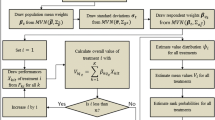Abstract
Medical decision making often utilizes subjective observations to arrive at concrete judgments. The decisions frequently affect who receives scarce medical treatments and, thus, who lives or dies. In this paper, a model health status index is described. It is specific for the problem of choosing patients for hemodialysis or transplantation. Such a health status index may be designed for any medical decision involving such issues as drug treatment priorities, identification of salvageable patients, and selection of patients for scarce medical treatment. This index (1) incorporates a physician's own medical criteria and values, (2) can be modified as the data base improves, (3) assures consistency from decision to decision, and (4) can be developed and used without the help of a mathematician or computer.
Similar content being viewed by others
References
Debreu, G., ‘Topological Methods in Cardinal Utility Theory’, inMathematical Methods in the Social Sciences, ed. by K. J. Arrow, S. Karlin, and P. Suppes, Stanford University Press, Stanford, 1969.
Fanshel, S. and Bush, J. W., ‘A Health Index and its Application to Health-Services Outcomes’,Operations Research 18, (1970) 1021–1066.
Hughes, W. L., Kalbfleish, J. M., Brandt, E. N., Jr., et al., ‘Myocardial Infarction; Prognosis by Discriminant Analysis’,Archives of Internal Medicine 111, (1963) 338–345.
Keeney, R. L., and Raiffa, H.,Decision Analysis with Multiple Objectives, John Wiley and Sons, New York, 1976.
Luce, R. D., and Tukey, J. W., ‘Simultaneous Conjoint Measurement: A New Type of Fundamental Measurement’,Journal of Psychology (1964/I) 1–27.
Norris, R. M., Brandt, P. W. T., Caughey, D. E.,et al., ‘A New Coronary Prognostic Index’,Lancet (1969/I) 274–278.
Pliskin, J. S.,The Management of Patients with End-Stage Renal Failure: A Decision Theoretic Approach, Doctoral Thesis, Harvard University, 1974.
Pliskin, J. S., and Beck, C. H., Jr., ‘Decision Analysis in Individual Clinical Decision Making: A Real-World Application in Treatment of Renal Disease’,Methods of Information in Medicine 15, (1976) 43–47.
Pliskin, J. S., and Beck, C. H., Jr., ‘A Health Index for Patient Selection: A Value Function Approach’,Management Science 22, (1976) 1009–1021.
Author information
Authors and Affiliations
Rights and permissions
About this article
Cite this article
Pliskin, J.S., Beck, C.H. A mathematical approach for establishing treatment priorities among patients. Metamedicine 1, 29–38 (1980). https://doi.org/10.1007/BF00883517
Issue Date:
DOI: https://doi.org/10.1007/BF00883517




